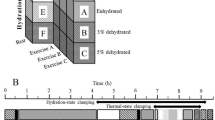Summary
Three male humans were subjected repeatedly to 20 min exercise on a bicycle ergometer: twice when hydrated normally and twice when dehydrated. Tympanic (Tty) and oesophageal (Tes) temperatures were recorded and sweat rates on forehead and back were measured. Dehydration did not change the forehead sweat rate, but on the back it reduced significantly, resulting in an increase of Tes. However, Tty was decreased by dehydration. 20 min after the end of exercise subjects were allowed to drink water in order to trigger the potohidrotic response. A potohidrotic response was noted on the back of dehydrated subjects only. It is concluded that dehydration results in active inhibition of sweating on the body but not on the forehead, where evaporation is needed for selective cooling of the brain.
Similar content being viewed by others
References
Adolph EG, and associates (1947) Physiology of man in the desert. Adolph EF (ed) Interscience, New York
Baker MA (1982) Brain cooling in endotherms in heat and exercise. Ann Rev Physiol 44:85–96
Caputa M (1980) Thermal gradients in the esophagus of man during exercise and passive warming. J Therm Biol 5:249–251
Caputa M (1981) Selective brain cooling: an important component of thermal physiology. In: Szelenyi Z, Szekely M (eds) Contributions to thermal physiology. Akademiai Kiado, Budapest, pp 183–192
Cabanac M, Caputa M (1979a) Natural selective cooling of the human brain: evidence of its occurence and magnitude. J Physiol 286:255–264
Cabanac M, Caputa M (1979b) Open loop increase in trunk temperature produced by face cooling in working humans. J Physiol 289:163–174
Cabanac M, Brinnel H (1985) Blood flow in the emissary veins of the human head during hyperthermia. Eur J Appl Physiol 54:172–176
Cabanac M, Massonnet B, Caputa M (1981) Independence of head and trunk temperature regulation in dehydrated humans. Fed Proc:1642
Cabanac M, Germain M, Brinnel, H (1987) Tympanic temperatures during hemiface cooling. Eur J Appl Physiol 56:534–539
Caputa M, Feistkorn G, Jessen C (1986) Competition for cool nasal blood between trunk and brain in hyperthermic goats. Comp Biochem Physiol 85A:423–427
Caputa M, Perrin G, Cabanac M (1978) Ecoulement sanguin réversible dans la veine ophthalmique: mécanisme de refroidissement sélectif du cerveau humain. CR Acad Sci 28:1011–1014
Dickenson AM (1977) Specific responses of cat raphe neurones to skin temperature. J Physiol 273:277–293
Dickenson AM, Hellon RF (1979) Falicitation and suppression of antidromic invasion by orthodromic impulses in the cat. J Physiol 289:57–58
Dickenson AM, Hellon RF, Taylor DCM (1979) Facial thermal input to the trigeminal spinal nucleus of rabbits and rats. J Comp Neurol 185:203–210
Dmi'el R (1986) Selective sweat secretion and panting modulation in dehydrated goats. J Therm Biol 11:157–159
Dostrovsky JO, Hellon RF (1978) The representation of facial temperature in the caudal trigeminal nucleus of the cat. J Physiol 277:29–47
Fuller CA, Baker MA (1983) Selective regulation of brain and body temperatures in the squirrel monkey. Am J Physiol 245:R293-R297
Greenleaf JE, Sargent F (1965) Voluntary dehydration in man. J Appl Physiol 20:719–724
Hertzman AB, Ferguson ID (1960) Failure in temperature regulation during progressive dehydration. US Armed Forces Med J 11:542–560
Maloiy GMO (1970) Water economy of the Somali donkey. Am J Physiol 219:1522–1527
Maloiy GMO (1973) The water metabolism of a small East African antelope: the dik-dik. Proc R Soc Lond B 184:167–178
Mc Caffrey TV, Mc Cook RD, Wurster RD (1975a) Effect of head skin temperature on tympanic and oral temperature in man. J Appl Physiol 39:114–118
Mc Caffrey TV, Geis GS, Chung JM, Wurster RD (1975b) Effect of isolated head heating and cooling on sweating in man. Aviat Space Environ Med 46:1353–1357
Nadel ER (1984) Effects of dehydration on heat transfer mechanisms in humans. Abstract 106, 10th Int Congr of Biometeorology, Toyko
Nadel ER, Fortney SM, Wenger CB (1980) Effect of hydrative state on circulatory and thermal regulation. J Appl Physiol 49:715–720
Nicolaidis S (1964) Etude d'une réponse de sudation après ingestion d'eau chez le sujet deshydraté. CR Acad Sci (Paris) 259:4370–4372
Nicolaidis S (1970) Réflexe potohidrotique et son rôle dans la régulation thermique et hydrominérale. Arch Sci Physiol 24:397–408
Nielsen B (1974) Effect of changes in plasma volume and osmolarity on thermoregulation during exercise. Acta Physiol Scand 90:725–730
Robertshaw D, Dmi'el R (1983) The effect of dehydration on the control of panting and sweating in the black Bedouin goat. Physiol Zool 56:412–418
Still AW (1982) On the number of subjects used in animal behaviour experiments. Anim Behav 30:873–880
Strydom NB, Holdsworth LD (1968) The effect of different levels of water deficit on physiological responses during heat stress. Int Z Angew Physiol Arbeitphysiol 26:95–102
Taylor CR (1970) Dehydration and heat: effects on temperature regulation in East African ungulates. Am J Physiol 219:1136–1139
Taylor CR (1972) The desert gazelle: a paradox resolved. Symp Zool Soc Lond 31:215–227
Author information
Authors and Affiliations
Additional information
N. Copernicus University, Institute of biology, Department of Physiology, PL-87100, Torun, Poland
Rights and permissions
About this article
Cite this article
Caputa, M., Cabanac, M. Precedence of head homoeothermia over trunk homoeothermia in dehydrated men. Europ. J. Appl. Physiol. 57, 611–615 (1988). https://doi.org/10.1007/BF00418471
Accepted:
Issue Date:
DOI: https://doi.org/10.1007/BF00418471




